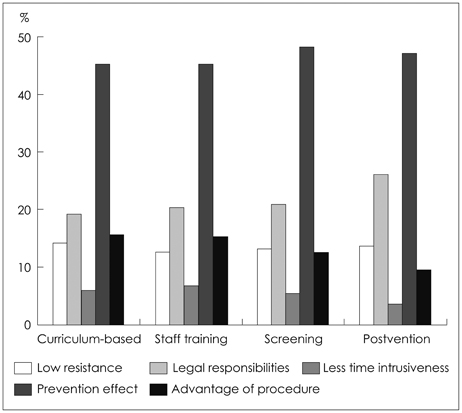J Korean Neuropsychiatr Assoc.
2014 Jan;53(1):8-14. 10.4306/jknpa.2014.53.1.8.
Suicide Prevention Program in Schools : Teacher's Perception of Benefits and Barriers
- Affiliations
-
- 1Suicide and School Mental Health Institute, Hallym University, Anyang, Korea. yskwn@catholic.ac.kr
- 2Chungwoon Elementary School in Seoul, Seoul, Korea.
- 3Department of Psychiatry, Hallym University Sacred Hospital, Hallym University College of Medicine, Seoul, Korea.
- 4Department of Psychiatry, The Catholic University of Korea College of Medicine, Seoul, Korea.
- KMID: 1964064
- DOI: http://doi.org/10.4306/jknpa.2014.53.1.8
Abstract
OBJECTIVES
The objective of this study was to identify the level of awareness regarding school-based suicide prevention programs in teachers who were in charge of the suicide prevention project, and to derive plans for future improvement.
METHODS
A total of 582 teachers working in elementary, middle, and high schools across the country participated in this study. For the study, school-based suicide prevention programs were divided into four programs : curriculum-based program, staff in-service training, screening, and postvention ; the teachers' opinions regarding each program were then gathered by conduct of an online survey.
RESULTS
The results indicated that participants chose the curriculum-based program as the most easily implementable program (65.6%), and postvention as the most difficult program to implement (52.9%). The curriculum-based program was implementable due to availability of procedure. Evasion of legal responsibility was significantly greater in postvention, making the program more desirable. Barriers to effective implementation include students' and parents' resistance to screening as well as time constraints in staff in-service training.
CONCLUSION
These results suggest that a variety of preceding conditions must necessarily be prepared for successful implementation of each type of suicide prevention program. Policy implications and future directions are then discussed.
Keyword
MeSH Terms
Figure
Reference
-
1. Korean National Statistical Office. Annual report on the cause of death statistics. 2001-2012. Available from: http://www.kostat.go.kr.2. Crosby AE, Sacks JJ. Exposure to suicide: incidence and association with suicidal ideation and behavior: United States, 1994. Suicide Life Threat Behav. 2002; 32:321–328.
Article3. Hayden DC, Lauer P. Prevalence of suicide programs in schools and roadblocks to implementation. Suicide Life Threat Behav. 2000; 30:239–251.4. Korean Educational Development Institute. The role of schools for suicide prevention of adolescents. Seoul: KEDI;2012.5. Eckert TL, Miller DN, Riley-Tillman TC, DuPaul GJ. Adolescent suicide prevention: Gender differences in students' perceptions of the acceptability and intrusiveness of school-based screening programs. J Sch Psychol. 2006; 44:271–285.
Article6. Gould MS, Greenberg T, Velting DM, Shaffer D. Youth suicide risk and preventive interventions: a review of the past 10 years. J Am Acad Child Adolesc Psychiatry. 2003; 42:386–405.
Article7. Kim GM, Kim JW, Kim JH. Current state of research on youth depression and suicide prevention. J Korean Med Assoc. 2012; 55:356–361.
Article8. McIntosh JL. Control group studies of suicide survivors: a review and critique. Suicide Life Threat Behav. 1993; 23:146–161.9. Whitney SD, Renner LM, Pate CM, Jacobs KA. Principals' perceptions of benefits and barriers to school-based suicide prevention programs. Child Youth Serv Rev. 2011; 33:869–877.
Article10. Kazdin AE. Acceptability of alternative treatments for deviant child behavior. J Appl Behav Anal. 1980; 13:259–273.
Article11. Miller DN, Eckert TL, DuPaul GJ, White GP. Adolescent suicide prevention: acceptability of school-based programs among secondary school principals. Suicide Life Threat Behav. 1999; 29:72–85.12. Eckert TL, Miller DN, Riley-Tillman TC, Dupaul GJ. Adolescent suicide prevention: Gender differences in students' perceptions of the acceptability and intrusiveness of school-based screening programs. J School Psychol. 2006; 44:271–285.
Article13. Greenhouse SW, Geisser S. On methods in the analysis of profile data. Psychometrika. 1959; 24:95–112.
Article14. Kalafat J. School approaches to youth suicide prevention. Am Behav Scientist. 2003; 46:1211–1223.
Article15. Eckert TL, Miller DN, DuPaul GJ, Riley-Tillman TC. Adolescent suicide prevention: school psychologists' acceptability of school-based programs. School Psychol Rev. 2003; 32:57–76.
Article16. Scherff AR, Eckert TL, Miller DN. Youth suicide prevention: a survey of public school superintendents' acceptability of school-based programs. Suicide Life Threat Behav. 2005; 35:154–169.
Article
- Full Text Links
- Actions
-
Cited
- CITED
-
- Close
- Share
- Similar articles
-
- Perceived Benefits and Barriers of Exercise in Community-Dwelling Adults at a Local City in Korea
- The Development of an Integrated Suicide Violence Prevention Program for Adolescents
- A Study on the Effectiveness of Adolescent's Suicide Prevention Program
- A Study on the Effects of a Jeollabuk-do Suicide Prevention Training Program for Professional Gatekeeper Instructors
- Relationships among Knowledge and Skills about Suicide Prevention, Attitudes toward Suicide, and Burnout of Suicide Prevention Work of Nurses at Mental Health Welfare Centers: A Mixed Methods Study



